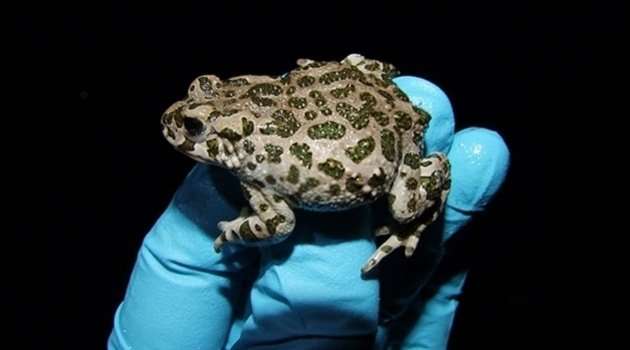The parasitic fungus Batrachochytrium dendrobatidis causes lethal infections in amphibians. Species and environment affect which frogs are infected by parasitic fungus. This is a green toad. Credit: Uppsala University
An aquatic parasitic fungus causes lethal infections in amphibians and is thought to be one of the reasons for a global decline in toad and frog populations. A new study by researchers from Uppsala University shows a wide variation among different species in the number of infections and that the surrounding environment has an impact.
The study was performed in Skåne, which is home to twelve amphibian species. The common frog, common toad, moor frog, European fire-bellied toad, European green toad and the natterjack toad were included in the study. The number of infections varied widely among the species. The common toad and common frog had the lowest proportion of infections, while the European green toad, the natterjack toad and the fire-bellied toad had the highest. In addition to the differences in the proportions of infected amphibians across the species, the infection rate was also affected by the environment in the ponds and surrounding landscape where the frogs and toads live. The proportion of infected individuals increased if the pH value in the pond was high and decreased if there was forest and many nearby ponds in the surrounding countryside.
Earlier studies have shown that the parasitic fungus (Batrachochytrium dendrobatidis) is sensitive to temperature and pH. Because the number of infected individuals was higher in ponds with higher pH values, the results suggest that the fungus is happiest in such environments. Likewise, forests can affect the prevalence of the fungus because it is relatively colder in wooded areas than in more open country. Some amphibian species avoid colder areas and ponds with specific pH values, which also affects the prevalence.
The video clip shows the researchers sampling a toad in the hunt for the parasitic fungus Batrachochytrium dendrobatidis. Credit: Uppsala University
More information: Simon Kärvemo et al. Effects of host species and environmental factors on the prevalence of Batrachochytrium dendrobatidis in northern Europe, PLOS ONE (2018). DOI: 10.1371/journal.pone.0199852
Journal information: PLoS ONE
Provided by Uppsala University





















